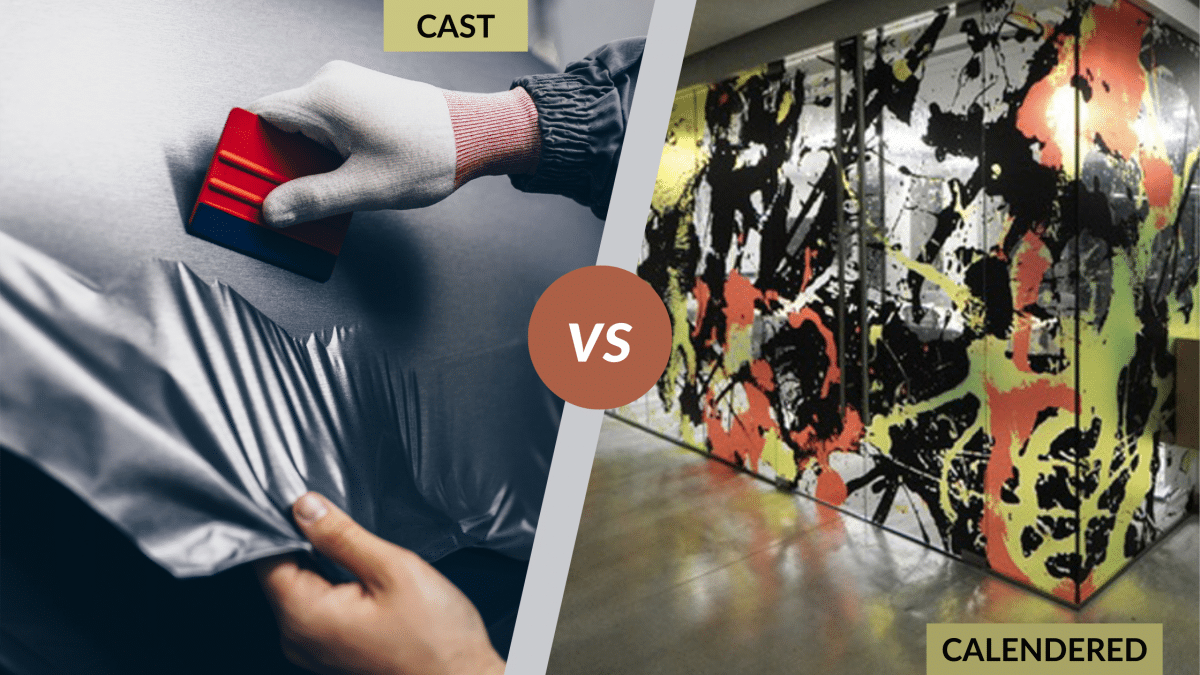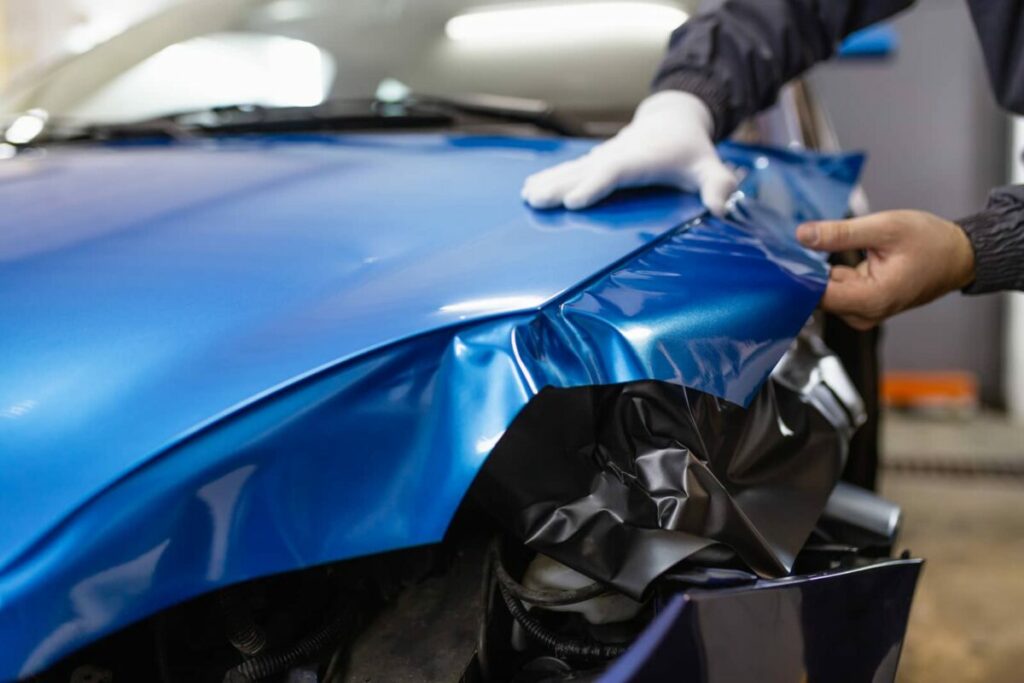
Choosing the Right Vinyl: A Comprehensive Guide to Cast and Calendered Vinyl Films
OCTOBER 17, 2023| rchauCategories
Vehicle WrapsAn In-Depth Handbook on Cast and Calendered Vinyl Films
Vinyl films are popular for various uses, like vehicle wraps and signage, due to their versatility, ease of installation, and design options. Choosing the right vinyl can be overwhelming, especially if you’re new to Cast and Calendered Vinyl differences. In this guide, we’ll explain Cast and Calendered vinyl, their features, pros, and cons. You’ll leave with a clear grasp of these vinyl types for your next project.
To start, it’s important to differentiate between adhesive vinyl and heat-transfer vinyl (HTV). Adhesive vinyl is the more common type and is a vinyl film with a sticky (adhesive) side and a non-adhesive side. There are currently two primary forms of mass production vinyl films: casting and calendering. Cast vinyl is a high-quality material that is thin, durable, and long-lasting, making it the best choice for vehicle wraps. On the other hand, Calendered vinyl is thicker and less expensive than Cast Vinyl, making it a popular choice for short-term applications such as promotional displays and indoor signage.
Factors to consider when choosing the right vinyl for your specific application include durability, longevity, finish, versatility, and cost. It’s also important to properly install and maintain vinyl films to ensure their longevity and effectiveness. In the next sections, we’ll delve deeper into Cast and Calendered Vinyl films, discussing their traits, pros, cons, and selection tips.

Cast Vinyl: Characteristics, Benefits, and Drawbacks
Cast Vinyl is a top-quality material, thin yet strong, perfect for vehicle wraps and outdoor signs. It works well on tricky surfaces with curves, rivets, and bumps without wrinkling. These films can last outdoors for over 7 years, looking good without fading or cracking. And you can easily remove them, which is great for advertising graphics and signs.
Cast vinyl comes in many colors and finishes, like gloss, matte, and satin, which last for years, even in tough conditions. But it’s pricier than Calendered vinyl and needs skill to install well. Consider all factors for your project: durability, longevity, finish, versatility, and cost.
Pros and Cons of Calendered Vinyl: What You Need to Know
Calendered Vinyl films work well for short-term uses like promotions and indoor signs. They’re thicker and more budget-friendly than cast vinyl, good for projects with limited lifespans. These films are best on flat surfaces but come in many colors and finishes, offering versatility. Here are some pros and cons of Calendered vinyl films:
Pros:
- Less expensive than cast vinyl films
- Available in a wide range of colors and finishes
- Suitable for short-term applications such as promotional displays and indoor signage
Cons:
- Thicker and less conformable than cast vinyl films
- Not suitable for complex surfaces with curves and corrugations
- Less durable and long-lasting than cast vinyl films
It’s important to consider all factors when choosing the right vinyl film for your specific project, including durability, longevity, finish, versatility, and cost. While Calendered Vinyl films may be a cost-effective option for short-term applications, they may not be the best choice for long-term projects or complex surfaces.
Factors to Consider When Choosing the Right Vinyl Film for Your Application
When selecting the ideal vinyl film for your project, it’s essential to consider several factors. First, think about the type of vinyl, whether it’s cast or calendared. Cast Vinyl is more flexible and conforms better to curved surfaces, making it suitable for complex applications like vehicle wraps. On the other hand, calendared vinyl is more affordable and works well for flat or slightly curved surfaces. Next, consider the intended use and durability requirements.
If your project will be exposed to harsh outdoor conditions, UV resistance and longevity should be top priorities. Additionally, think about the adhesive type – permanent or removable – based on how long you want the vinyl to stay in place. Lastly, color options and finish (gloss, matte, or specialty) should align with your design vision. By carefully evaluating these factors, you can confidently choose the right vinyl film for your specific application.

How to Determine the Durability and Longevity of Vinyl Films
Evaluating the durability and longevity of vinyl films is crucial when selecting the right one for your project. Start by examining the manufacturer’s specifications, particularly the product’s expected lifespan. Additionally, consider where and how the vinyl will be used. If it’s exposed to the sun or harsh weather, look for UV-resistant options.
For demanding applications, cast vinyl is often more durable. Reading reviews or seeking recommendations from professionals who have used the vinyl in similar conditions can also provide valuable insights into its longevity. Finally, assess the warranty offered by the manufacturer, as it can be an indicator of the vinyl’s quality and expected performance over time. By considering these factors, you can make a more informed choice to ensure your vinyl film lasts as long as needed for your project.
Tips for Proper Installation and Maintenance of Vinyl Films
To make vinyl films last and look good, proper installation and maintenance are crucial. Start with a clean, debris-free surface. Use tools like squeegees and heat guns to apply the vinyl smoothly and remove air bubbles. Follow manufacturer instructions carefully, and if unsure, consider professional help for a perfect finish.
Maintenance involves regular cleaning with mild soapy water to remove dirt and contaminants. Avoid abrasive cleaners or tools that could scratch the vinyl’s surface. In the case of damaged or peeling edges, address them promptly to prevent further issues. Overall, a little care and attention to installation and maintenance can go a long way in keeping your vinyl film looking great for years to come.
Conclusion
Navigating the vinyl film landscape can seem like a daunting task, especially when you’re faced with the nuanced differences between Cast and Calendered Vinyl types. Think of it like choosing between two delicious pastries; one might be perfect for a hearty breakfast, while the other shines as a light afternoon treat. Cast vinyl, akin to that indulgent croissant, is your go-to for those big, lasting projects. In contrast, calendered vinyl is like your everyday muffin – more economical, but still packing a punch for the short-term. Remember, it’s not just about picking the right ‘flavor’ of vinyl, but also lovingly baking (or in this case, installing) it to perfection and giving it the care it deserves. So, as you embark on your next creative endeavor, let this guide be your recipe book, leading you to a project that not only looks fantastic but feels just right to your touch. Happy crafting!
Craving more savory details on vinyl selection and care? Dive into our latest blog post and let us unravel more tips and tricks for you. Click here to continue your vinyl journey!
